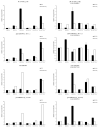Integration of Small RNA and Degradome Sequencing Reveals the Regulatory Network of Al-Induced Programmed Cell Death in Peanut
- PMID: 35008672
- PMCID: PMC8745729
- DOI: 10.3390/ijms23010246
Integration of Small RNA and Degradome Sequencing Reveals the Regulatory Network of Al-Induced Programmed Cell Death in Peanut
Abstract
Peanut is one of the most important oil crops in the world. In China, the peanut is highly produced in its southern part, in which the arable land is dominated by acid soil. At present, miRNAs have been identified in stress response, but their roles and mechanisms are not clear, and no miRNA studies have been found related to aluminum (Al)-induced programmed cell death (PCD). In the present study, transcriptomics, sRNAs, and degradome analysis in the root tips of two peanut cultivars ZH2 (Al-sensitive, S) and 99-1507 (Al-tolerant, T) were carried out. Here, we generated a comprehensive resource focused on identifying key regulatory miRNA-target circuits that regulate PCD under Al stress. Through deep sequencing, 2284 miRNAs were identified and 147 miRNAs were differentially expressed under Al stress. Furthermore, 19237 target genes of 749 miRNAs were validated by degradome sequencing. GO and KEGG analyses of differential miRNA targets showed that the pathways of synthesis and degradation of ketone bodies, citrate cycle (TCA cycle), and peroxisome were responded to Al stress. The combined analysis of the degradome data sets revealed 89 miRNA-mRNA interactions that may regulate PCD under Al stress. Ubiquitination may be involved in Al-induced PCD in peanut. The regulatory networks were constructed based on the differentially expressed miRNAs and their targets related to PCD. Our results will provide a useful platform to research on PCD induced by Al and new insights into the genetic engineering for plant stress response.
Keywords: aluminum stress; degradome; microRNAs; peanut; programmed cell death; regulatory network.
Conflict of interest statement
The authors declare no conflict of interest.
Figures











Similar articles
-
Transcriptome analysis reveals significant difference in gene expression and pathways between two peanut cultivars under Al stress.Gene. 2021 May 20;781:145535. doi: 10.1016/j.gene.2021.145535. Epub 2021 Feb 23. Gene. 2021. PMID: 33631240
-
Identification of wild soybean miRNAs and their target genes responsive to aluminum stress.BMC Plant Biol. 2012 Oct 5;12:182. doi: 10.1186/1471-2229-12-182. BMC Plant Biol. 2012. PMID: 23040172 Free PMC article.
-
Small RNA profiling and degradome analysis reveal regulation of microRNA in peanut embryogenesis and early pod development.BMC Genomics. 2017 Mar 2;18(1):220. doi: 10.1186/s12864-017-3587-8. BMC Genomics. 2017. PMID: 28253861 Free PMC article.
-
Role of microRNAs in aluminum stress in plants.Plant Cell Rep. 2014 Jun;33(6):831-6. doi: 10.1007/s00299-014-1565-z. Epub 2014 Jan 11. Plant Cell Rep. 2014. PMID: 24413694 Review.
-
Role of microRNAs in programmed cell death in renal diseases: A review.Medicine (Baltimore). 2023 Apr 14;102(15):e33453. doi: 10.1097/MD.0000000000033453. Medicine (Baltimore). 2023. PMID: 37058073 Free PMC article. Review.
Cited by
-
Genome-Wide Characterization of Ascorbate Peroxidase Gene Family in Peanut (Arachis hypogea L.) Revealed Their Crucial Role in Growth and Multiple Stress Tolerance.Front Plant Sci. 2022 Sep 9;13:962182. doi: 10.3389/fpls.2022.962182. eCollection 2022. Front Plant Sci. 2022. PMID: 36186077 Free PMC article.
-
New frontiers of soil fungal microbiome and its application for biotechnology in agriculture.World J Microbiol Biotechnol. 2023 Aug 26;39(11):287. doi: 10.1007/s11274-023-03728-8. World J Microbiol Biotechnol. 2023. PMID: 37632593 Review.
-
Overexpression of microRNA-205-5p promotes cholangiocarcinoma growth by reducing expression of homeodomain-interacting protein kinase 3.Sci Rep. 2023 Dec 17;13(1):22444. doi: 10.1038/s41598-023-49694-x. Sci Rep. 2023. PMID: 38105269 Free PMC article.
-
Physiological and Proteomic Changes in Camellia semiserrata in Response to Aluminum Stress.Genes (Basel). 2023 Dec 29;15(1):55. doi: 10.3390/genes15010055. Genes (Basel). 2023. PMID: 38254944 Free PMC article.
-
Endoscopic liquid biopsy of bile: superior diagnostic and prognostic performance of bile-derived exosomal miR-21-5p for biliary tract cancers.J Gastroenterol. 2025 Jul;60(7):905-916. doi: 10.1007/s00535-025-02250-y. Epub 2025 Apr 23. J Gastroenterol. 2025. PMID: 40268789
References
MeSH terms
Substances
LinkOut - more resources
Full Text Sources

